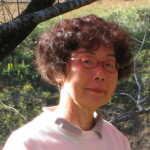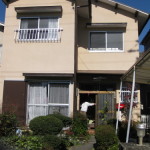Kyoko chatters as she steers the car along a narrow road through the cedars. Their unmistakable scent born of long, dry heat fills the air. Shafts of light pierce the spaces between the trees. While drinking in this sensuous splendor I fight the urge to panic as the car’s right wheel gets closer and closer to the tiled ditch.
“Please, stay on the road, Kyoko-san,” I say trying to mask my fear in dulcet tones. She laughs, pulls the wheel and rescues us from a long wait—or a long walk—in this forest.
Some miles away from the JR Sonobe station (about 40 minutes out of Kyoto in the Kyotamba region) we head toward the community onsen (hot spring bath). Not the one she regularly visits because it closes for cleaning on Wednesdays, but another farther away.
Kyoko bathes in the community onsen every day. She credits the thermal mineral waters for her good health and flawless skin (which many women in their 30s would envy though she is in her 60s.) Every day! I had no idea. That means for the next week I will enjoy an onsen every day as well. What bliss.
I met Kyoko when she was president of Kyoto International Service Club a dozen or so years ago. (I’ll tell you all about Kyoto ISC in the next post.) At that time she assigned guides for several school exchange trips I conducted and helped us navigate the city. Our students charmed the guides, and the same ones joined us more than once.
Afterwards I kept in touch. As we discussed meeting during this private visit and learning that I couldn’t get a hotel in Kyoto (because it was the height of autumn leaf viewing season) Kyoko kindly invited me to stay in her home. She said I could catch the train to Kyoto from Sonobe as her house in Kyotanba-cho was near the station.
- Kyoko
- Kyoko’s House
Envisioning a short stroll from the railway station to her house, I’m surprised to learn that she is a half hour’s drive from Sonobe station. A little muddle between my urban and her rural understanding of the word near. Who knew? In mere minutes I’m well off any tourist map I have. Just one of many surprises in store.
After a few kilometers we pass out of the forest into a valley tightly encircled by hills. Now, the sun is well behind them, but its last rays illuminate a massive golden statue of Kannon Bodhisattva (goddess of mercy) looking down from the eastern hillside in radiant welcome.
We park outside the Kannon-yu community centre, enter, and according to local custom, undress and lock up our clothes. For some reason I have no squeamishness about nudity in the bath or being nude in front of others that some non-Japanese do. After we wash our bodies we make our way to the rotenburo (outdoor pool), this one rust-dark with iron-rich mineral water. For half an hour we sink to our earlobes in the soothing, restorative spring. I am limp with warmth right to the marrow.
The rest of the week, no matter what else fills our day, Kyoko and I visit Springs Hiyoshi, her regular stop at the foot of the Hiyoshi Dam in Nanton before dinner. Here we see the same faces, women of the local villages and farms who idobata kaigi (chatter around the well) the way it was done in the time before texts and tweets. Shy but curious, as Kyoko’s friend they welcome me into their circle. Before long I feel right at home.


